
Isn’t creating funnels on whiteboards, spreadsheets, or worse still, paper, a big hassle?
Add to it the struggles of coordinating with your team, tracking data, studying analytics, spotting gaps, and updating your funnels for the best results.
Funnelytics puts an end to all such problems for you.
Put simply, Funnelytics is one of the best funnel mapping, tracking, and optimization software. It’s the first tool of its kind to focus on funnel visualization—which, coupled with tracking analytics, makes every marketer’s job easier.
While it’s an extremely useful tool, there are also many Funnelytics alternatives in the market that might interest you or suit your needs better.
But before we explore those alternatives, let’s first understand what Funnelytics does.
What is Funnelytics?
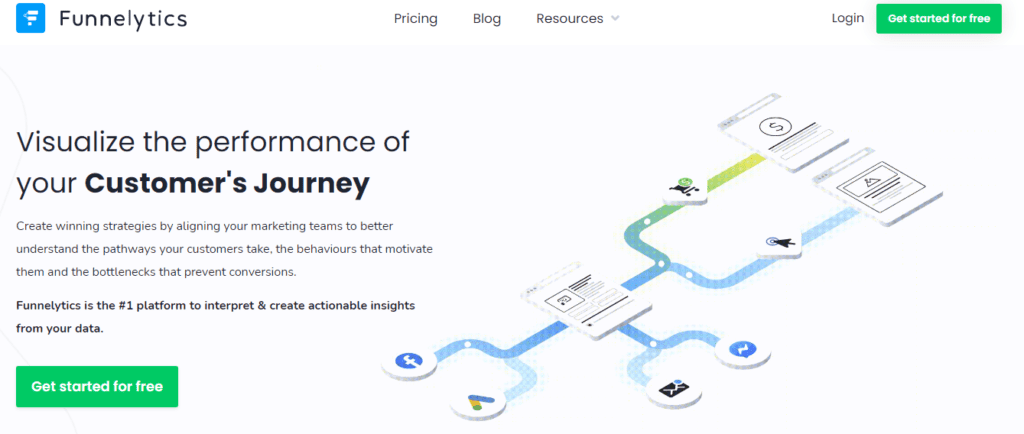
Funnelytics helps you create a visual representation of your funnels on its canvases and forecast results before you go on to build and launch your funnels.
Besides mapping, it also helps you track every channel of your funnel, determine its overall effectiveness, and thus, optimize it.
Pros
- Quick and easy way to map out funnels using drag-and-drop.
- Tracks traffic, visitors, conversions, and ROI.
- The Funneytics Vault gives access to funnel templates from top marketers, with videos explaining how to use them.
- Makes team collaboration smooth as you can download funnel ideas or share them through links.
- You can forecast results before creating a funnel.
Cons
- Funnelytics is still in the beta phase.
- Allows you to only design and analyze your funnels. You need other tools to build and publish them.
- Doesn’t offer heatmaps or visitor recordings.
- Doesn’t integrate with email marketing tools or funnel builders.
- Doesn’t integrate with shopping carts or payment processors.
- The free version doesn’t provide tracking and analytics. It’s only good for brainstorming funnel ideas.
Best suited for: Marketing professionals, business and agency owners.
Pricing: Funnelytics has a Starter (free), Marketer, and Pro version. The Marketer plan costs $470/year, while the Pro plan costs $790/year.
10 Best Funnelytics Alternatives You Should Check Out
1. Mouseflow
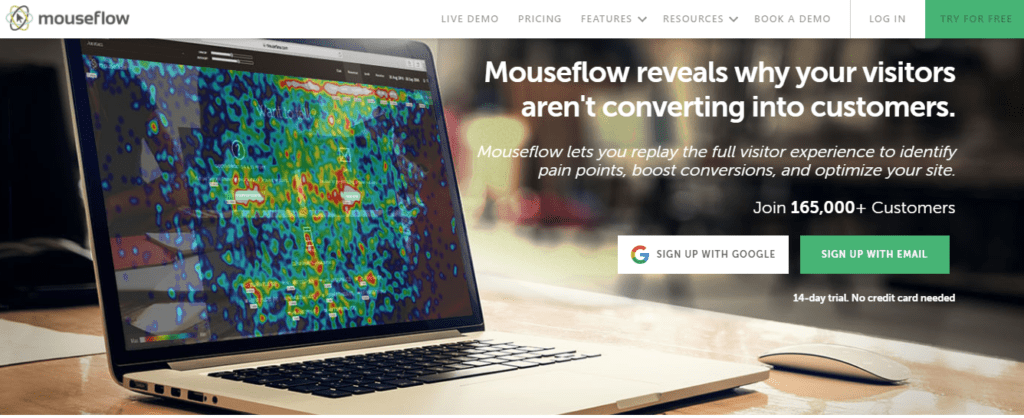
Mouseflow is a tool that shows you how visitors interact with your website.
Features like funnels, heatmaps, session replays, and customer feedback, help you understand how visitors use your website—where they click, how far they scroll, where they get stuck, etc. Using these insights, you can improve your pages and conversion rates.
Pros
- User-friendly interface with easy-to-understand features.
- Using session recordings, you can see your website through your visitors’ eyes—you can analyze their experience and understand where and why they dropped off.
- Allows you to filter sessions to only watch those that help you discover problems on your website.
- Flexibility to integrate with platforms like WordPress, Shopify, Wix, Blogger, etc.
- Free 14-day trial.
Cons
- Session recordings can be glitchy sometimes.
- You can’t filter and choose the sessions you want to record.
- Heatmaps can be difficult to understand, especially for beginners.
- Uses data sampling, i.e. it tracks only a percentage of the total website traffic.
- Retains data for only one month—you can increase this only if you upgrade your plan.
Best suited for: Digital marketers, UX designers, web analysts, and product managers.
Pricing: Mouseflow offers many plans, including a free one. The Starter, Growth, Business, and Pro plans respectively cost $24, $79, $159, and $299 per month when billed annually.
2. Google Analytics
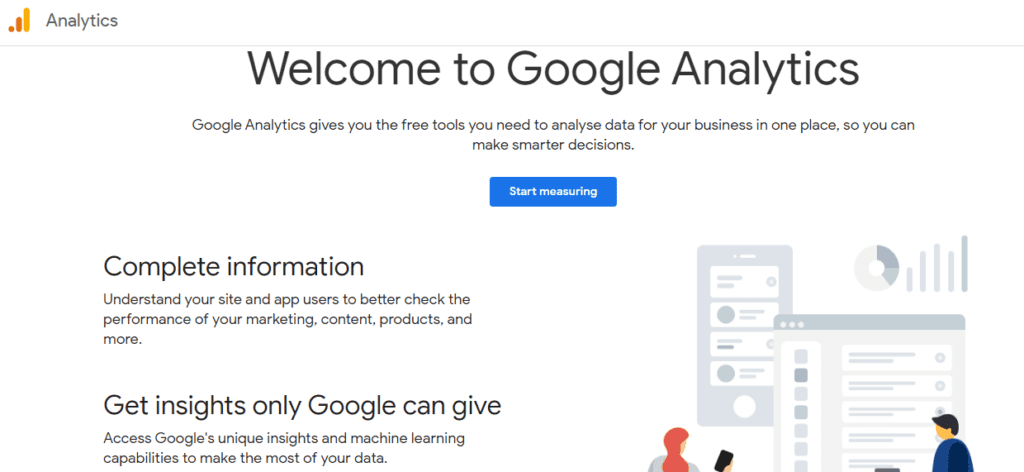
Google Analytics tracks and reports website traffic—it provides data on who visits your website, where they come from, and how they navigate it. This information can help you understand your customers and find profitable channels for your business.
You can also use Google Analytics to analyze and collect data for your mobile app.
Pros
- Reports on website/app performance are shareable.
- Shows the source of traffic and collects real-time traffic data.
- Easy to set up and integrates with tools like Google Adwords, Google Search Console, etc.
- Presents data using visuals, like pie charts, website flow visuals, etc.
- Collects rich data on the audience—like their age, gender, location, device types.
- Offers predictive analysis, i.e. it forecasts performance based on current and past data.
- Also available as a mobile app version.
Cons
- Provides metrics like conversion rates and traffic flow, but doesn’t integrate them into your funnel map, as Funnelytics does.
- Uses data sampling.
- Can’t remove bot traffic automatically.
- Google Analytics script can be blocked using ad blockers.
- Data privacy issues may arise, and Google may use the data collected through your website.
- The premium version is very costly.
Best suited for: Anyone who wants to track website traffic and analytics.
Pricing: Google Analytics is a freemium service. The free version works sufficiently well for small businesses. The premium version, called Google Analytics 360, costs $150,000 a year.
3. SmartLook
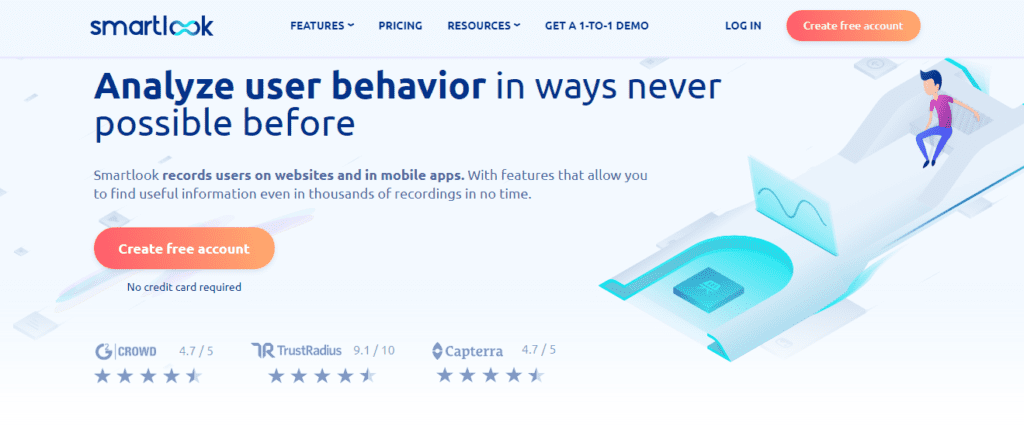
SmartLook provides qualitative and quantitative analytics by recording user actions on websites and in mobile apps.
Like Mouseflow, it also has features like heat maps, visitor recordings, event tracking, and funnels—thus helping you understand the visitor behavior and journey at the micro-level.
Pros
- It shows how users interact with not just websites but also mobile apps.
- It is a lightweight addition to apps and doesn’t affect performance or speed majorly.
- Easily integrable with software like WordPress, Shopify, and Google Analytics.
- Doesn’t sample recordings, i.e. it records the activity of every visitor on your website.
- Offers more than 30 filters for better analysis of data.
- In visitor recordings, you can fast-forward to events you want to see.
Cons
- The dashboard style can seem complex.
- Sharing recordings isn’t as easy.
- Heatmaps can be difficult to understand.
- Privacy controls are lagging and unclear.
- In the free version, all data gets blocked after you hit 1500 visits in a month.
Best suited for: e-commerce business owners, SMBs, B2B vendors, and CRO specialists.
Pricing: Besides a free version, SmartLook has a Startup and a Business plan, priced at $31 and $79 per month, respectively. They also have an Ultimate plan to customize your features, and they set the price accordingly.
4. Hotjar
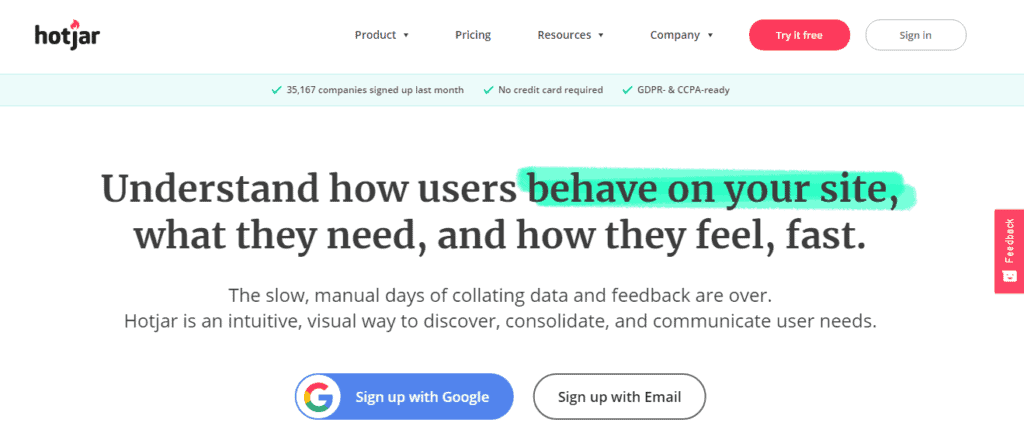
An excellent Funnelytics alternative, Hotjar shows you the visitor journey on your website through tools like heatmaps, recordings, and funnel analytics.
What makes it different is that it allows you to take feedback directly from your users—instead of guessing why they came to your site, why they left and what pain points they faced.
Pros
- Provides analysis and feedback—not many heatmap tools offer this combination.
- Easy to install, understand and use with a user-friendly interface.
- You can use surveys, forms, polls to engage visitors and get customer feedback.
- No limit on the number of people with whom you can share data.
- 365-days data retention policy—helps you make better comparisons and observe trends.
- Also available as a mobile app.
Cons
- Not suitable to analyze mobile apps—it’s only compatible with websites and web-based applications.
- There’s a limit (1500px) on the maximum page height that can be recorded.
- Doesn’t offer predictive analytics.
- Only integrates with seven software presently.
- No feature to segment visitors based on new or returning visitors, location, time, etc.
- Samples data.
Best suited for: SaaS companies, product managers, e-commerce businesses, B2C companies.
Pricing: Hotjar offers four plans – Personal Basic (free), Personal Plus ($39/month), Business ($99/month), and Scale ($389/month).
5. ClickFunnels
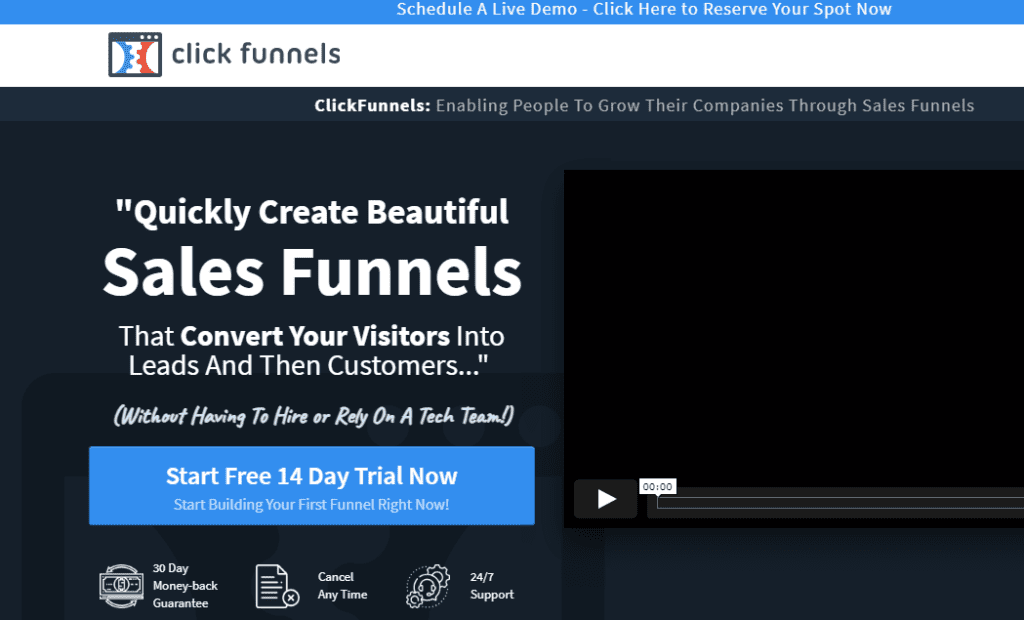
ClickFunnels is a marketing and sales funnel builder—using which you can create custom landing pages, opt-in pages, sales pages, and more.
It helps you build effective funnels and track their performance using its analytics tools, thus helping you boost sales and conversions.
Pros
- Easy to understand and use, even if you’re not tech-savvy.
- Offers templates of high-converting funnels that you can customize and use.
- You can build every element of your funnel—from landing pages to shopping carts, all in one place.
- You can integrate it with your CRM or email marketing systems.
- Integrates with multiple payments systems like PayPal, Stripe, etc.—you can collect payments on your website pages without directing customers to a third party.
- Allows easy and efficient A/B testing for website pages.
Cons
- Takes time to set up.
- Security issues may arise.
- The software and its email marketing tool, Actionetics, can be glitchy sometimes.
- You don’t have ownership of the pages you create—ClickFunnels owns everything. If you leave, you’ll have to start from scratch.
- Poor support—it allows users to answer support queries, and a dedicated support team steps in much later.
- Very costly, especially for small businesses.
Best suited for: Entrepreneurs, B2B and B2C marketers and business owners, e-commerce business owners.
Pricing: Basic plan costs $97 per month, while the Advanced plan costs $297 per month. A 14-day free trial is available, but otherwise, there’s no free version of ClickFunnels.
6. Geru

Another great Funnelytics alternative, Geru, is a digital marketing funnel simulator that helps you plan funnels and forecast marketing results before setting up any pages. It simulates the potential profits of your funnels using actual or hypothetical data.
Even if you already have funnels in motion, you can plan extensions and explore new ideas to maximize profits with Geru.
Pros
- Using their calculator and simulator, you can understand your funnel’s potential and determine metrics like estimated ROI, revenue, profit, etc., before you spend a penny.
- Easy drag-and-drop feature to map funnels.
- Allows A/B testing of funnels.
- The ‘Blueprint Library’ contains proven funnel templates that you can use.
- You can set your dream profit goal, and Geru will show you how you can achieve it.
- An in-built planner that shows you how far along you’ve come in creating your funnel.
Cons
- You cannot build or launch funnels using Geru. It is only a funnel mapper and simulator.
- Doesn’t offer analytics.
- Works best if you already have data on your business’ conversion rates and profits. Their suggested rates cannot bring the most accurate simulations.
- Creates new business scenarios very quickly—which means it’s easy to get lost or distracted if you don’t have a concrete business plan already.
- No free version is available.
Best suited for: Info product marketers, e-commerce sellers, marketing agencies, lead gen marketers, SaaS brands.
Pricing: The Standard and Pro plans cost $27/month and $59/month, respectively, when billed annually.
7. ContentSquare
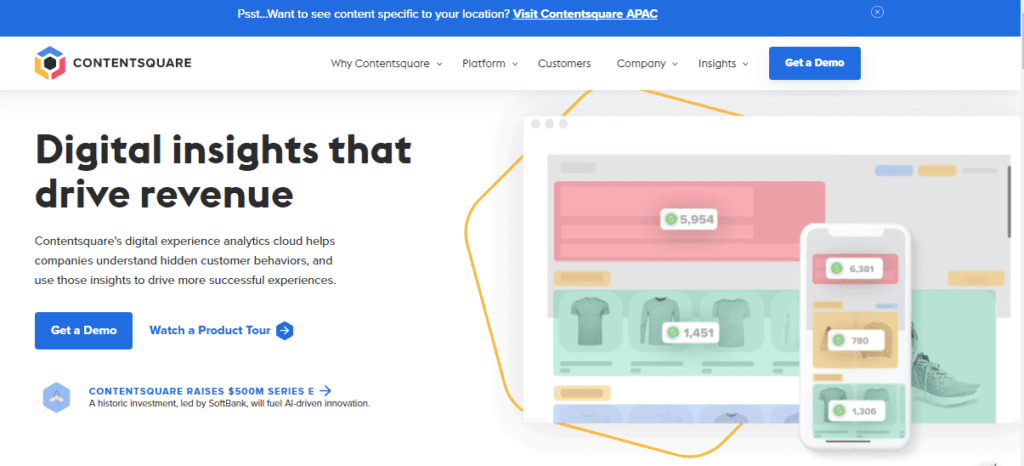
ContentSquare is an analytics platform that helps you analyze user behavior on your website or app through features like session replays and heatmaps.
It anonymously tracks all mouse movements, scrolls, and clicks and prepares an analysis—using which you can improve the visitor experience and increase conversions.
Pros
- Simple and easy setup—you just need to add a tag to your website or SDK in your mobile app, and ContentSquare will start tracking.
- The tag is lightweight and doesn’t affect website performance.
- Provides visual representations of data, which is easy to understand and interpret.
- Has a dedicated training and certification program where you can learn everything about the software.
- The CS Live Chrome Extension allows you to work and track outside of the platform.
- Collects all user data without sampling.
Cons
- Stores data for only three months. You need to pay extra to increase this limit.
- More suitable for brands with large volumes of traffic.
- Cannot compare the performances of different devices side-by-side.
- Doesn’t include feedback tools.
- No sampling can sometimes mean that you will have to sieve through and analyze large volumes of data.
Best suited for: UX designers, digital marketers, analysts, conversion managers.
Pricing: Customized pricing as per requirements.
8. TruConversion
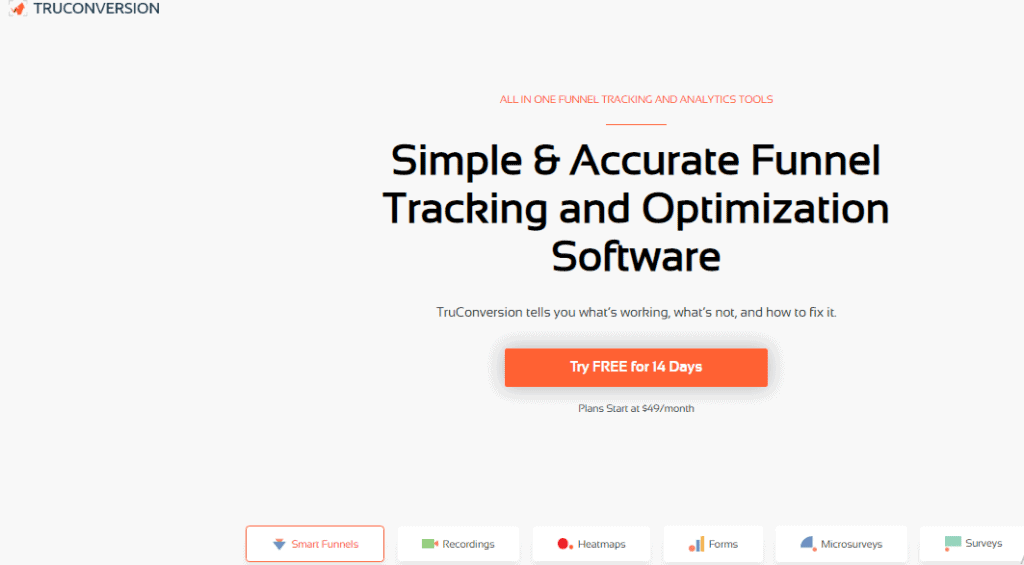
TruConversion is a marketing funnel tracking and optimization tool that offers insights into the user’s journey and allows you to take feedback directly from visitors and customers.
It provides both analytics and feedback through features like heatmaps, session replays, micro surveys, field reports, etc.
Pros
- Easy setup—insert the TruConversion script in your website, and it starts tracking.
- You can select events you want to record.
- Advanced filters to help you find specific information.
- Data is downloadable and shareable.
- A single account can track multiple domains.
- Allows you to get qualitative data directly from the audience.
- Integrates with WordPress, Mailchimp, Shopify, Hubspot, etc.
Cons
- Their Smart Funnels tool doesn’t have branching capabilities.
- Doesn’t offer funnel templates as yet.
- Can’t share survey reports directly through email.
- No mobile version.
Best suited for: Media managers and social media marketers.
Pricing: Basic, Plus, and Pro plans cost $41, $83, $149 per month when paid annually. It has agency plans for big businesses. Additionally, you get two months free when you pay yearly. 14-day free trial available.
9. Pendo
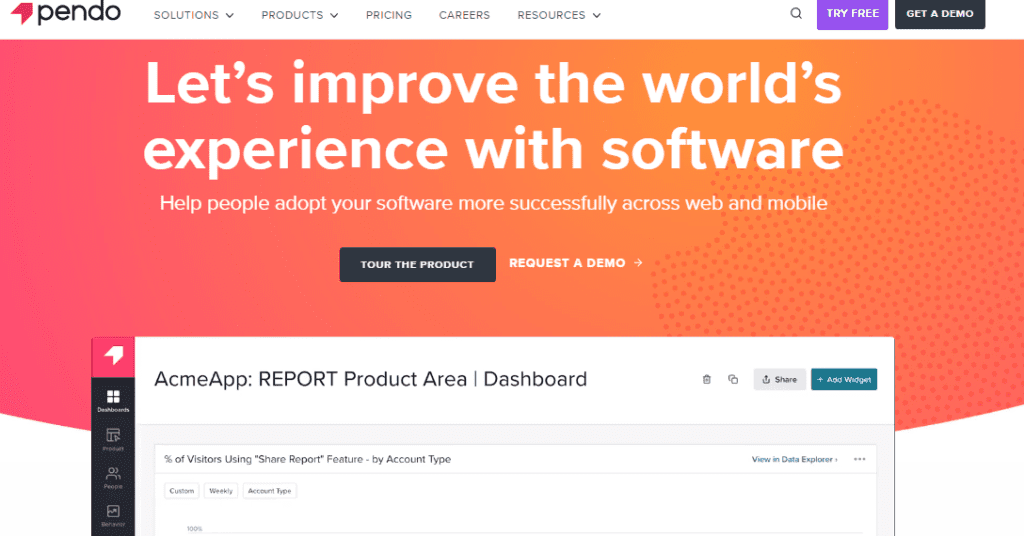
Pendo is a product-analysis app that helps you understand how customers interact with your app or website.
Not only does it show you what users are doing on their product journey—but it also helps you guide them within your product and take feedback from them.
Pros
- Easy and fast setup.
- Provides analytics and guidance in one platform.
- You can create interactive guides that help visitors understand how to use your product.
- Allows you to collect feedback from visitors using surveys, polls, NPS, etc., and keep them updated on the status of their suggestions.
- Also gives quantitative product insights.
- Integrates with software like Slack, Hubspot, Zendesk, etc.
Cons
- Requires a slight learning curve.
- Understanding heatmaps and the analysis reports can be difficult.
- Difficult to keep the guides up and running when you’re introducing new features to your product.
- Doesn’t provide session recordings.
- Data is not very granular.
- UI can seem clunky, and software can be buggy sometimes.
Best suited for: Software makers, product managers, and product teams.
Pricing: It has a free version, but the prices of its Team and Pro plans haven’t been disclosed.
10. FullStory
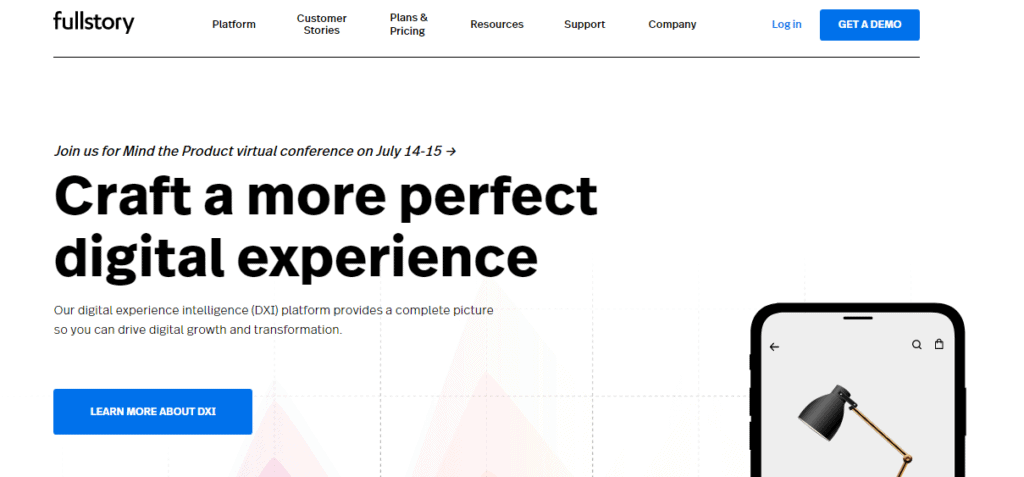
FullStory is a website analytics and conversion tool. It records visitors’ browser behavior and helps you discover pain points and improve customer experience.
With tools like heatmaps, session recordings, and funnel analytics, you can visually understand what customers see and use on your website.
Pros
- Indexes every single interaction a user has with your website and makes it searchable.
- Easy to filter through recording sessions and find important events.
- Provides weekly, monthly, and yearly reports of your website.
- Excellent tool to solve grievances and improve the experience of individual customers.
- Free trial available.
Cons
- Easy to get lost and confused as it generates a lot of data.
- For websites with high traffic, collecting and storing such large amounts of data can be difficult and costly.
- Requires a high learning curve.
- Known to slow down website or app performance in some cases.
- No mobile version is available and the website is not very mobile-friendly.
- Minor bugs and glitches may occur.
Best suited for: Product designers and managers, and UX designers.
Pricing: Besides a free plan, there is a Business and an Enterprise plan—their prices depend on the customer and their requirements.
What’s your favorite Funnelytics alternative?
Funnelytics is an excellent tool to solve your marketing needs and problems. It takes the pain out of funnel mapping and makes it a practical, fun, and interesting exercise for you and your team.
It also allows you to track the performance of your funnels and marketing campaigns.
But if it doesn’t match your requirements, or if you simply want to explore and experiment with new tools, make sure to check out the above Funnelytics alternatives.
About Rachel Bowland
Rachel Bowland is the content manager at Social Marketing Writing. She likes to write about marketing and design.
